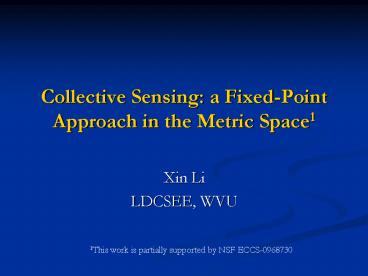Collective Sensing: a Fixed-Point Approach in the Metric Space1
1 / 18
Title:
Collective Sensing: a Fixed-Point Approach in the Metric Space1
Description:
Title: PowerPoint Presentation Last modified by: Windows User Created Date: 1/1/1601 12:00:00 AM Document presentation format: On-screen Show (4:3) –
Number of Views:147
Avg rating:3.0/5.0
Title: Collective Sensing: a Fixed-Point Approach in the Metric Space1
1
Collective Sensing a Fixed-Point Approach in the
Metric Space1
- Xin Li
- LDCSEE, WVU
1This work is partially supported by NSF
ECCS-0968730
2
Unreasonable Effectiveness of Mathematics in
Engineering
- Unreasonable effectiveness of mathematics in
natural sciences Wigner1960 - To understand how nature works, you need to grasp
the tool of mathematics first - The tension between mathematicians and engineers
- Wavelets vs. filter banks
- the hype that would arise around wavelets caused
surprise and some understandable resentment in
the subband filtering community in Where do
wavelets come from? I. Daubechies1996 - Compressed sensing is another example of how
mathematicians have stolen the show from engineers
3
Mathematical Structures are Double-Bladed Swords
Metric space a set with a notion of distance
Hilbert-space a complete Inner-product space
General relativity Fixed-point theorems Game
theory Dynamic systems
Quantum mechanics Fourier/wavelet analysis Learn
ing theory PDE(e.g., Total-Variation)
Mathematical constructivism (Poincare, Brouwer,
Weyl )
Mathematical formalism (Hilbert, Ackermann, Von
Neumann )
4
Criticism of Compressed Sensing
- Where does sparsity come from?
- Nonlinear processing of wavelet coefficients
- Nonlinear diffusion minimizing TV
- What is wrong?
- Over-emphasize the role of locality (it does not
hold in complex systems) - Inner-product is an artificial structure (it
carries little insight about how patterns form in
nature)
basis functions
signal of interest
approximation of l0
5
A Physical View of Sparsity
- How nature works? (e.g., variational principle)
- Reaction-diffusion systems A. Turing1952
- More is Different. P.W. Anderson1972
- Self-organizing systems I. Prigogine1977
- Fractals and Chaos Mandelbrot1977
- Complex networks 1990s-
- Implications into image processing
- Hilbert space might not be a proper mathematical
framework for characterizing the complexity of
natural images?
6
From Hilbert-space to Metric-space
- Images are viewed as the fixed-points in the
metric space fPf - Nonlinear mapping P characterizes the
organizational principle underlying images - Example (nonlocal filter)
Bilateral , nonlocal mean and BM3D filters are
special cases of PNLF
Non-expansiveness of PNLF guarantees the
existence of fixed-points
7
Phase Space of Image Signals
SA-DCT
TV
BM3D
Nonlocal-TV
Nonlocal filters
Local filters
8
Nonlocal Regularization Magic
BM3D
Nonlocal-TV
Key Observation As the temperature
(regularization) parameter varies,
nonlocal models can traverse different phases
corresponding to coarse/fine structures
9
From Compressed Sensing to Collective Sensing
- Key messages
- From local to nonlocal regularization thanks to
the fixed-point formulation in the metric space
(PNLF depends on the clustering result or
similarity matrix) - From convex to nonconvex optimization
deterministic annealing (also-called graduated
nonconvexity) is the black magic behind
10
Variational Interpretations
TV
Nonlocal TV
BM3D
11
Application (I) Collective Sensing
l1-magic PSNR68.53dB
Ours PSNR84.47dB
l1-magic PSNR19.53dB
Ours PSNR40.97dB
12
Application (II) Lossy Compression
NL-enhanced
NL-enhanced
JPEG-decoded
SPIHT-decoded
House (256256)
Barbara (512512)
MATLAB codes accompanying this work are available
at my homepage http//www.csee.wvu.edu/xinl/ or
Google Xin Li WVU
13
Image Comparison Results
NL-enhanced at rate of 0.32bpp (PSNR33.22dB)
JPEG-decoded at rate of 0.32bpp (PSNR32.07dB)
SPIHT-decoded at rate of 0.20bpp (PSNR26.18dB)
NL-enhanced at rate of 0.20bpp (PSNR27.33dB)
Maximum-Likelihood (ML) Decoding
Maximum a Posterior (MAP) Decoding
14
Application (III) Image Deblurring
ISNR(dB) comparison among competing deblurring
schemes for cameraman image uniform 99 blurring
kernel and noise level of BSNR40dB
15
Image Comparison Results
original
degraded
TVMM
IST
SADCT
Ours
16
Unexpected Connections
- Spectral clustering
- Eigenvectors of graph Laplacian determine a
provably optimal embedding - Nonlinear dynamical systems
- Regularization implemented by the joint force of
excitation and inhibition in a neuron network - Statistical physics
- Variational principle underlying Ising model,
spin glass and Hopfield network
17
Summary and Conclusions
- One way of competing with mathematicians is to
think like physicists - Basis construction/pursuit is only one (local and
suboptimal) way of understanding sparsity - Nonlocal regularization can more effectively
handle complexity of natural images - The distinction between signals and systems is
artificial and a holistic (collective) view is
preferred
18
Ongoing Works
- Duality between similarity and dissimilarity
- The implication of sensory inhibition into image
processing - From graphical models to complex networks
- The role of complex network topology
- Unification of signal reconstruction and object
recognition - To remove the artificial boundary between
low-level and high-level vision































